There’s no point to beat around the bush on the topic of great content. If you want people to read your stuff, it must be of exceptional quality. And it’s clear as day that the standard for producing great content is changing, too. Brands, even individual bloggers, are required to put in much more thought and effort in producing content that’s worthy of attention.
On any given day, tens of millions of content pieces get published all across the web. From personal blogs to brand pages, to extended social media content. And this creates not only saturation but also fierce competition.

If you go back to mid-2000s, you’ll see that the majority of content produced back then was simple listicles. They worked as informative pieces, but there was not much else to it. This has now changed.
Lest we forget that SEO also plays a significant role in how content is being created nowadays. Google has refined and fine-tuned the search engine so much so that it’s mandatory to follow a few guidelines in content creation. This is good news though, because once you learn about and adapt yourself to this checklist — every single content piece you produce is going to shine!
So, if you’re ready to improve your content quality and see an increase in readership — keep reading as we narrate an entire checklist of things to keep in mind!
#1: Think in Terms of Content Design
Content Design is a fairly new concept, but one that’s popular among the most prominent writers and publishers. Essentially, content design is the concept of providing readers with irrefutable value in the best possible way.
You can think of content design in the following steps:
- Generate a new content idea.
- Write an article/blog about the said idea.
- Optimize text, images, videos, and other types of content to provide a diverse user experience.
- Make the said content accessible through design elements.
So, for example, the above steps (or a list) is a great example of a design element added to the content. It makes it easier for you, the reader, to understand and digest the said principles.
People are used to skimming through content (because who has time to read these days), so adding “skimmable” elements to your content is a brilliant place to start.

Likewise, you can use photos to add not only color to your content but also informative content in an easy to understand format. Further, photos are oftentimes the one thing that readers share on their social media profiles.
By creating quotes, statistics, and other templates — you can garner extra brand exposure through having your content shared across multiple channels.
And in the case of this example, we’ve taken the above quote from Smart Insights. Which means that Smart Insights also gets to benefit from the backlink factor of content design.
Understand a problem and help solve it
One last thing on the topic of content design. It’s easy to pick a keyword and think of it in terms of a whole new content piece. But, more often than not, people are looking for real solutions to real problems. And, as such, it’s extremely important that you first understand the specific problem yourself.
Afterward, you can craft content that actually takes your readers on a step-by-step basis through the given problem. This means that you’ll need to spend more time doing research, maybe even involve talking to real people who are experts in the specific field. It really does make a difference in the quality of your content, and ultimately, readership.
#2: Content is King & SEO is Queen
It’s fairly simple. You don’t want to produce 3,000-word content pieces without tying in SEO in the mix. The potential for organic traffic is still here and will continue to be for many years to come. So, it will only help you to understand the different SEO tactics used in content production.
But first, the fundamentals:
- Google values site performance as a ranking factor. Make sure your content can be accessed quickly and efficiently.
- External links to relevant information matter, so do internal links to previously written content.
- Google’s algorithm is getting much better at understanding genuine content. As a result, it pays to write from personal experience.
Of course, there are a lot of other things to take in. And there are also a lot of great SEO tools that can help you in crafting better content.
Featured snippets are growing in popularity
In my experience over the last year or so, it seems that almost every single Google search query is now showing a featured snippet.
Google’s search results sometimes show listings where the snippet describing a page comes before a link to a page, not after as with our standard format. Results displayed this way are called “featured snippets.”
We display featured snippets when our systems determine this format will help people more easily discover what they’re seeking, both from the description about the page and when they click on the link to read the page itself. They’re especially helpful for those on mobile or searching by voice.
Featured snippets commonly contain one listing, but more than one may appear.
And they look something like this:
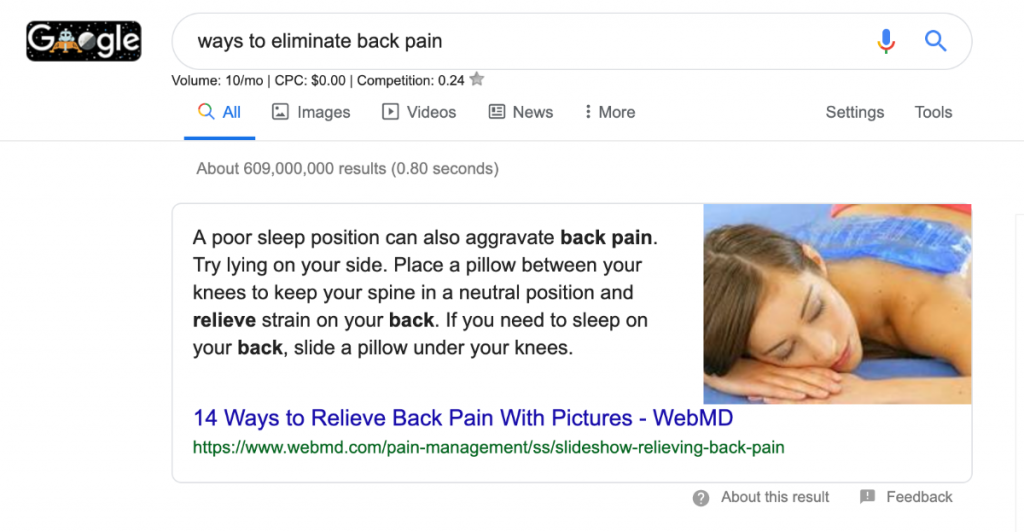
In simple terms, Google is choosing to highlight a specific answer to a question from any given content site. The answer is oftentimes a single paragraph from a whole piece of content. But, it’s not uncommon for Google to use multiple sentences together. It seems that it’s more important for keywords to be a match than anything else.
Nevertheless, you can write content in a way that helps you get highlighted in such featured answer boxes. And one of the ways to do it is to format your content with clearly written, succinct paragraphs.
If you splurt out big walls of text without any formatting, it’s unlikely that Google is going to favor you in their featured snippets boxes.
Focus on plain and communicative language
It’s nice to have literary experience and an eloquent writing style, but you have to understand that search engines are not necessarily that smart. Besides, there are numerous studies that showcase that readers prefer clear and communicative content over jargon and hard to understand lexicon.
Plain language simply means that you’re making your content accessible to a wider audience. And Google loves to reward content that’s simple, to the point, and without any unnecessary extra narrative.
It comes back to the previous point about featured snippets. If you can explain something in one paragraph, why attempt to do it in three?
Write on topics that you feel most comfortable with
Always start with topics in which you have actual tangible expertise. The fact of the matter is, your readers will easily tell whether you’re actually trying to be informative, or simply trying to sound smart for the sake of putting out more words for your article.

Also, by writing about things you’re truly passionate about — you’re allowing yourself to learn the ropes of producing wonderful content. It’s so much easier to write on things you know than those you don’t know.
And, it’s not uncommon to end up in a painful burnout phase when you overwork yourself for the sake of growth and exposure.
#3: Add depth with long-tail keywords
Keyword research is serious business. A keyword tells you what users are searching for, and provides you with an opportunity to deliver content in that area. And in recent times, there has been explosive growth in the field of long-tail keywords.
In SEO, we distinguish between head keywords and long tail keywords. A long tail keyword is more specific than a head keyword, and most of the times – but not necessarily – it consists of more words. The head keyword is a general term lots of people write about. A long tail keyword is a more specific topic or a subtopic of the head term. Usually, less people create content about this topic.
Yoast SEO
You can also take a look at this illustration:
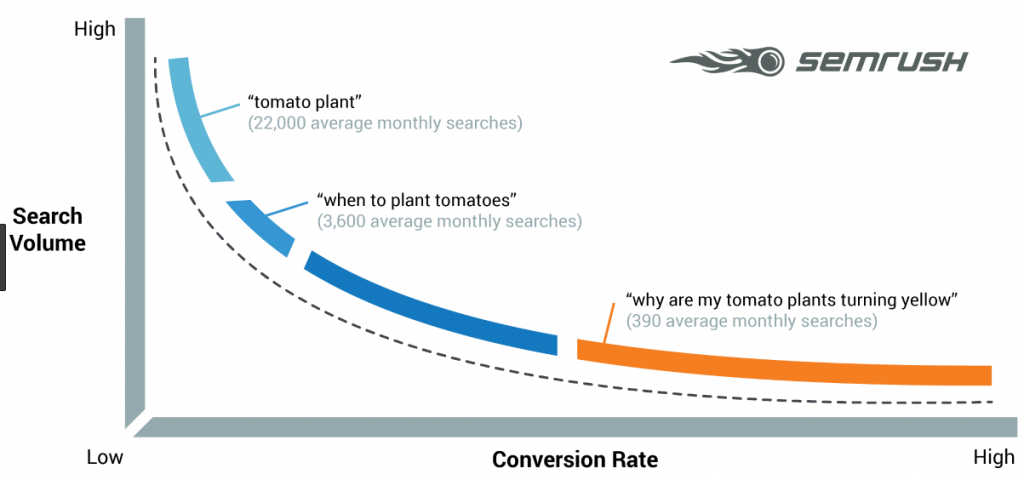
As you can tell, long-tail keywords focus on the depth of a specific topic and or subject. So, you might be wondering, where to get data on long-tail keywords? Fortunately, a lot of sites now provide such information. In fact, Google itself does this through its autocomplete search feature.
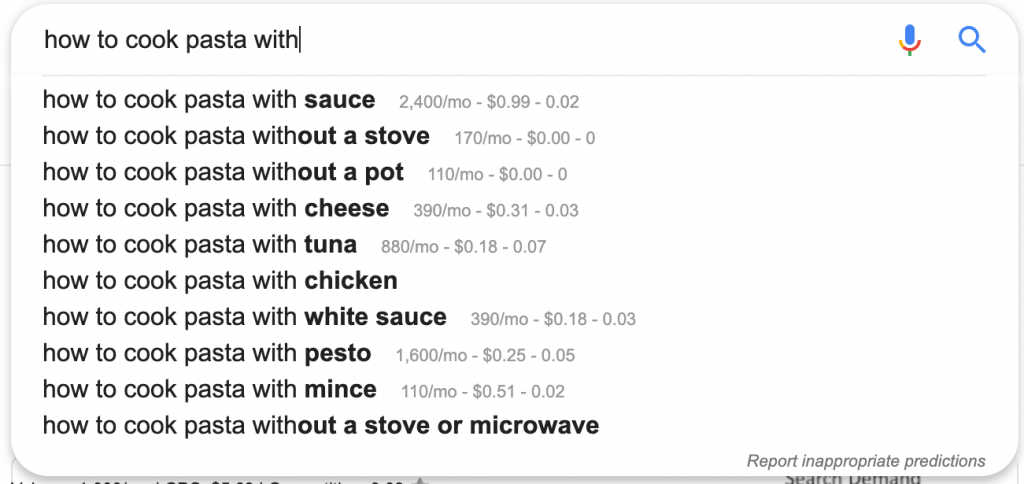
You can type in any kind of a question/keyword and Google itself will provide deeper search queries. And if you use a browser add-on such as Keywords Everywhere — you’ll also get instant monthly search volume data.
If you have access to tools such as Ahrefs or SEMRush, then finding long-tail keywords shouldn’t be an issue for you. Do keep in mind that both of the said tools cost a substantial amount of money for a monthly subscription.
A free alternative to use for finding long-tail keywords would be the Answer The Public site.
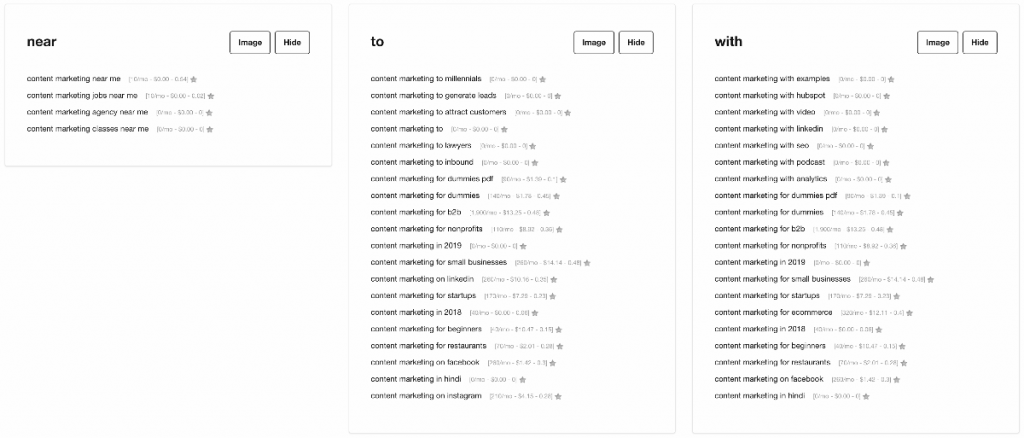
Here you can put in any kind of a keyword/phrase, and the site will provide alternative long-tail keywords. The recommendations come in the form of questions, prepositions, comparisons and more.
And likewise, by using the Keywords Everywhere extension, you’ll see instant stats on the search volume for each given recommendation.
#4: Take Time to Understand Your Audience
Everyone has an idea of their perfect audience persona. But, it’s not that simple. You won’t figure out your perfect audience type solely by envisioning it in your mind. It takes a lot of content, a lot of feedback and critique, and a lot of paying attention.
Because by paying attention, you’re going to learn about your audience on a deeper level. You’ll see what content performs best and why. You’ll see which posts get most social shares and by what kind of people.

It goes without saying that simple things like writing tone can attract an entirely different audience type to your site. So, you have to pay attention to that as well. Some blogs perform great not because they look “nice” but because their content adds tremendous value to the reader.
Zen Habits, a website dedicated to articles on wellness and mindfulness, is an excellent example of this. Even though the site attracts millions of monthly readers, the site design is extremely minimal. In fact, you won’t even find a single image anywhere.
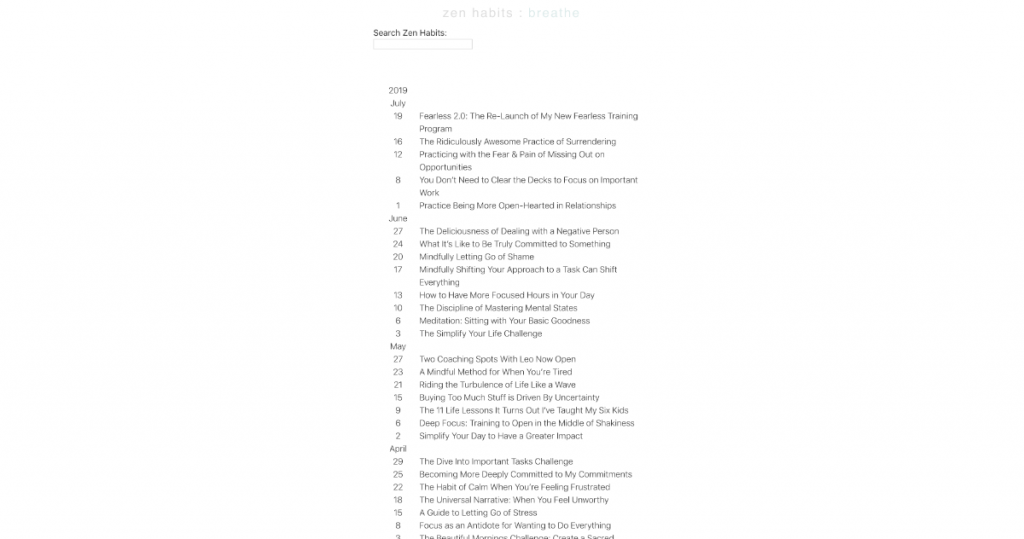
But, because the content is high-quality and targets a specific audience — it all works. And the same can be said about sites that invest heavily in the visual aspect of things. There are people who enjoy visuals more than they enjoy nice lists and neatly organized paragraphs.
In due time, you will also understand what your audience likes and dislikes. The important part is to constantly reexamine your own understanding of the people who consume and engage with your content.
#5: Look At What Others Are Doing
Although a checklist such as this one is nice to go over and learn from, there’s still a lot more you’re going to learn from experimenting directly by yourself.
However, another thing you can do is look at what everyone else is doing. More specifically, monitoring your closest competitors and taking a look at their content strategy.
What kind of content are your competitors publishing the most? Which of their content is getting the most views or social media shares? You can learn a lot just by looking at what others are doing. Do a simple search for the keywords you’re targetting and take a look around.
You’re guaranteed to come across new and interesting ideas that you can implement in your personal content plan. As the saying goes among content marketers, “If you’re going to steal it, better make sure you improve it!”.
#6: Research As Much As You Can
Nobody likes an empty bowl of rice for dinner, not every night anyway. The same goes for content that’s not thoroughly researched. The more time you put into research, the more value you’re giving to the reader. In a sense, you’ve done all the hard work on their behalf. And it pays to do it.
Take Quora as an example. A relatively simple questions and answers site yet attracts hundreds of millions of monthly visitors. Furthermore, Quora has an extremely active and bustling community. A lot of the community members don’t mind going in-depth for specific answers.
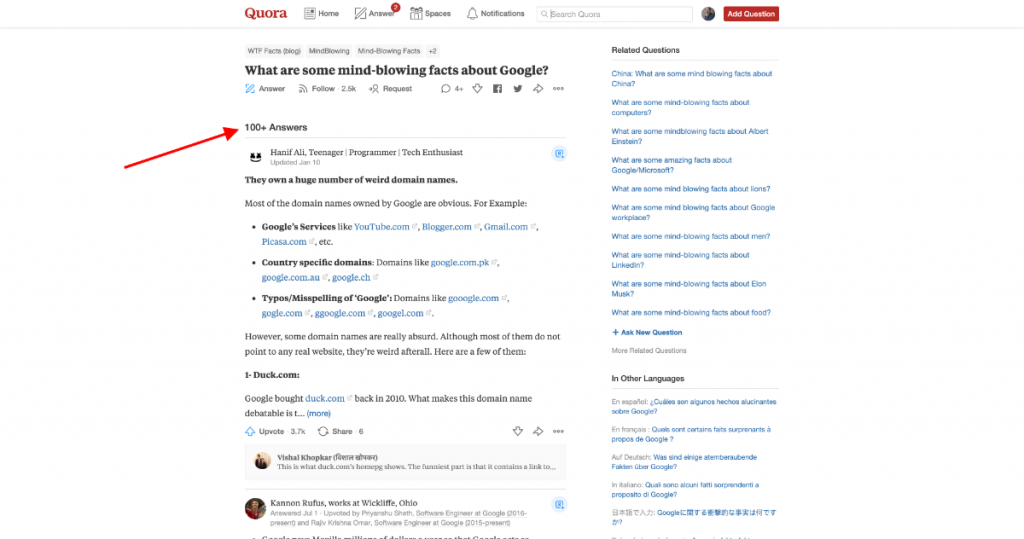
And this is your golden opportunity to gather interesting information on a subject. Things that perhaps no one else would ever know. Albeit, Quora is not the only site providing such value. Sites like Hacker News, Reddit, even tools like Ahrefs — all provide immense potential for high-quality research.
Last but not least, Google itself is a goldmine for finding critical information exactly when you need it. I guess the more important factor is the willingness to invest your time into doing proper research.
#7: Write Down What You Learn
And when I say learn, I mean specifically about content marketing and content creation in general. It was such a huge boost in my own success when I started writing down the things I had learned each day.
Anything related to marketing is not a one-way street. There are quirks and there are concepts to understand. But if you try to manage it all in your head all the time, you’re going to end up burned out.
So, by writing stuff down — not only are you creating memories of what you’re learning, but you’re also creating a reference point for whenever you need it. As a personal recommendation, I advise using a real journal and a real pen. It has an entirely different effect on your ability to learn things quickly.
Closing words
Creating world-class content is a tough task. Each day a new competitor is launching their content marketing strategy. Each week, there are adjustments to overall Google rankings for sites that are investing their time in proper SEO promotion. And each month, there is truckloads of new information and data becoming available on your specific niche.
Keeping up with all this is no easy task. But stick with it. Get in the groove of producing content that gets better with every new post you finalize. Do little experiments like using different types of images. Experiment with site design and see if your bounce rate doesn’t go down.
But most importantly, continue learning about content and how content can be used to boost your brand. There are tremendous opportunities in content marketing, and all it takes is strong willpower and dedication to succeed.

























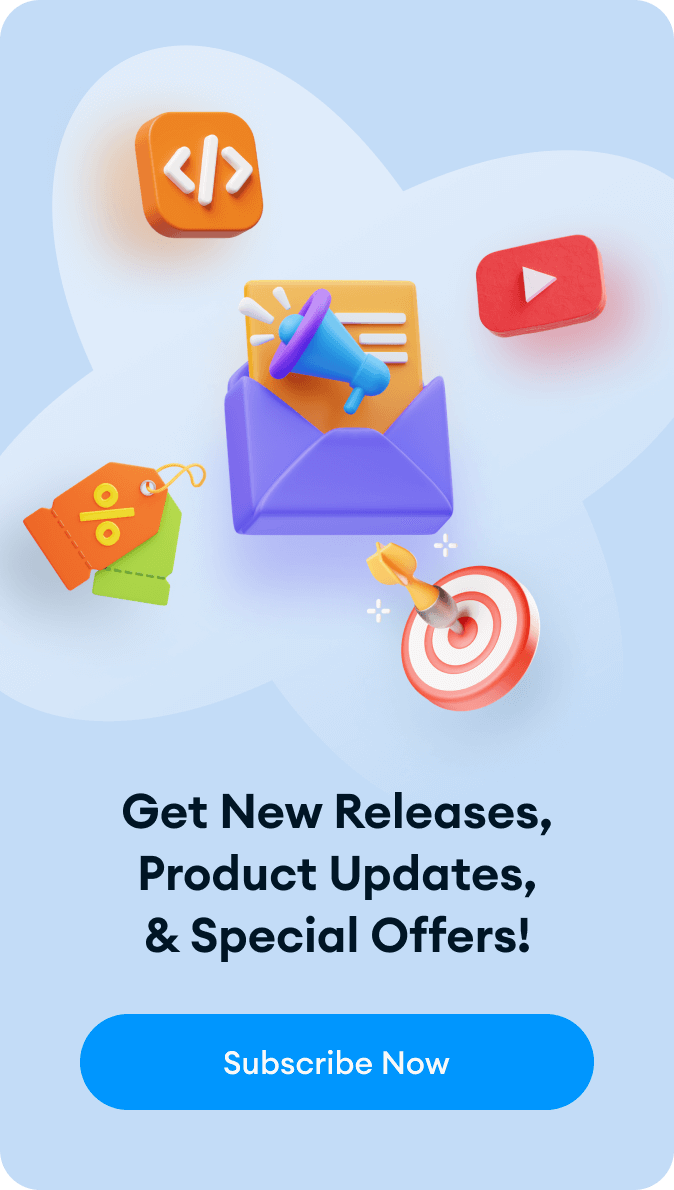


Thank u for the content.